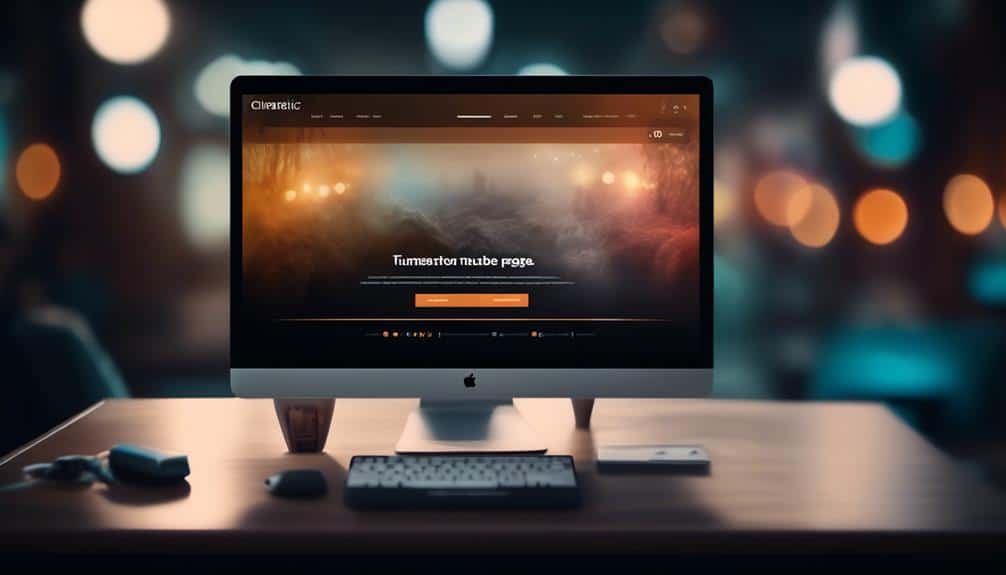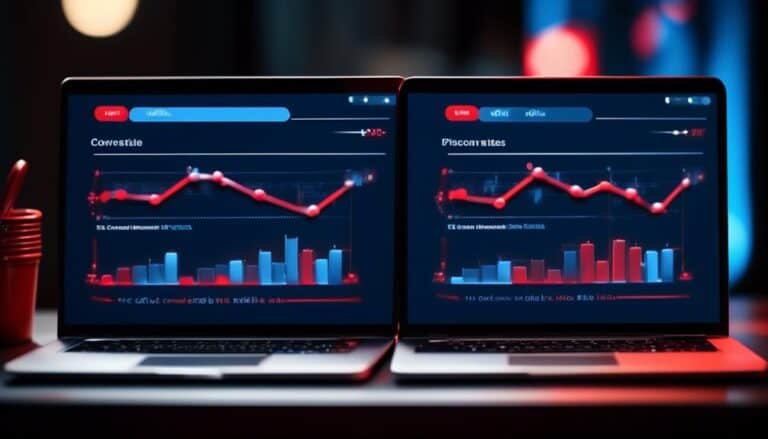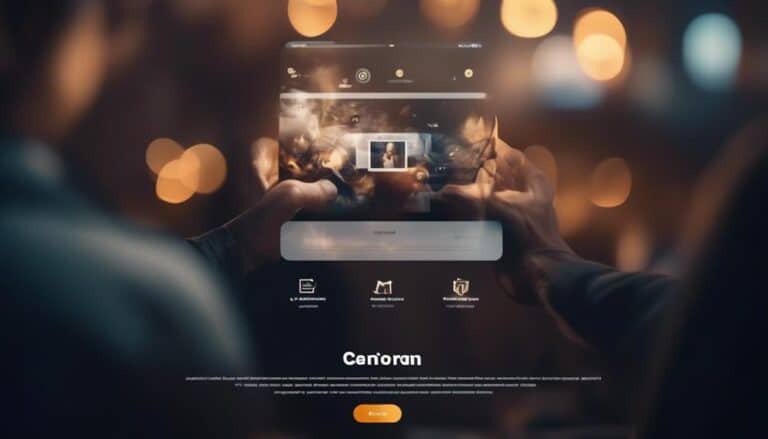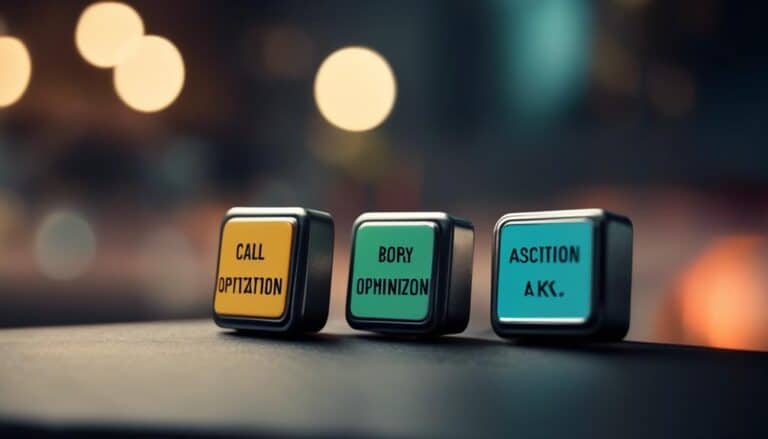Psychology of Persuasion: How to Design Landing Pages That Convert
Picture your landing page as a digital storefront, each element strategically placed to beckon visitors inside. From the colors you choose to the testimonials displayed, every detail plays a crucial role in enticing potential customers to take action.
As you navigate the intricate landscape of online persuasion, mastering the art of designing landing pages that convert is both a science and an art form. Dive into the intricate web of psychological triggers and design techniques that can turn passive visitors into engaged leads, and ultimately, loyal customers.
Key Takeaways
- Incorporate trust signals like testimonials and reviews to build credibility
- Utilize urgency triggers such as limited-time offers and countdown timers to create a sense of FOMO
- Tap into reciprocity by offering valuable resources for free to visitors
- Enhance emotional connections through compelling storytelling and visually appealing elements
The Power of Social Proof
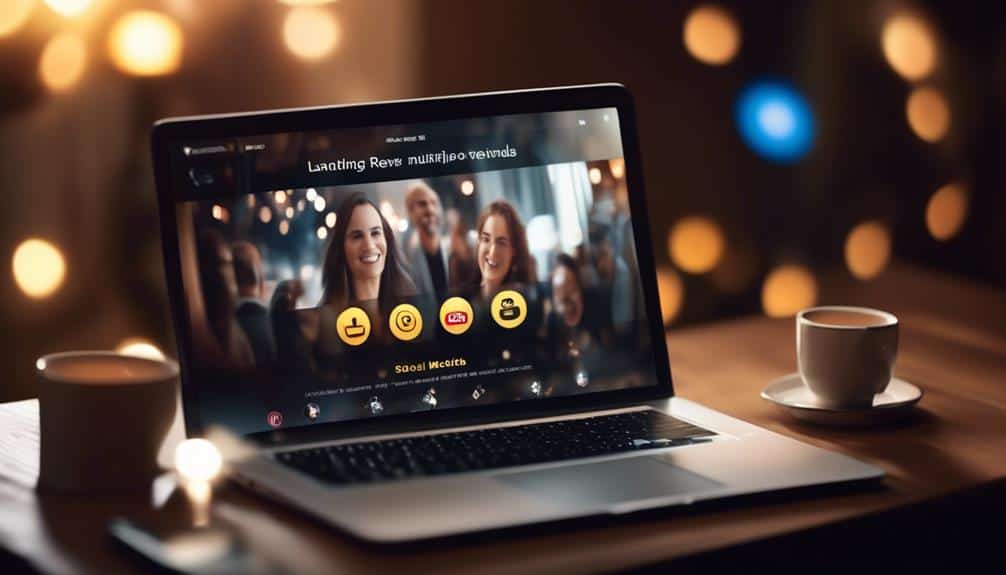
Utilize the persuasive influence of social proof to enhance the conversion rates of your landing pages. By incorporating trust signals and leveraging social influence, you can significantly impact the decisions of your website visitors. Trust signals, such as customer testimonials, reviews, and endorsements from reputable sources, establish credibility and authenticity, reassuring users that your product or service is reliable. These signals act as social proof, demonstrating to potential customers that others have found value in what you offer.
Furthermore, social influence plays a crucial role in shaping consumer behavior. When individuals see that a large number of people have already taken a desired action, such as making a purchase or signing up for a newsletter, they're more likely to follow suit. By showcasing metrics like the number of satisfied customers, social media shares, or positive ratings, you create a sense of FOMO (fear of missing out) that compels visitors to join the ranks of your satisfied clientele. In essence, harnessing the power of social proof can instill confidence in your audience and drive conversions on your landing pages.
Leveraging Scarcity Tactics
Implementing scarcity tactics can create a sense of urgency and drive conversions on your landing pages. Scarcity tactics effectiveness is rooted in behavioral psychology, tapping into the human tendency to place higher value on items that are perceived as scarce or in limited supply. By leveraging urgency triggers such as limited-time offers, low stock alerts, or countdown timers, you can prompt visitors to act quickly, increasing conversion rates.
The fear of missing out (FOMO) is a powerful motivator that scarcity tactics capitalize on. When visitors believe they may lose out on a valuable opportunity, they're more inclined to take immediate action to secure the offer. This sense of urgency plays into basic human psychology, triggering a response that leads to quicker decision-making and higher conversion rates.
Incorporating scarcity tactics strategically into your landing page design can create a sense of exclusivity and desirability around your product or service, compelling visitors to convert before the opportunity slips away. By understanding the behavioral psychology behind scarcity tactics and utilizing them effectively, you can optimize your landing pages for maximum conversion results.
Influence of Reciprocity Principle
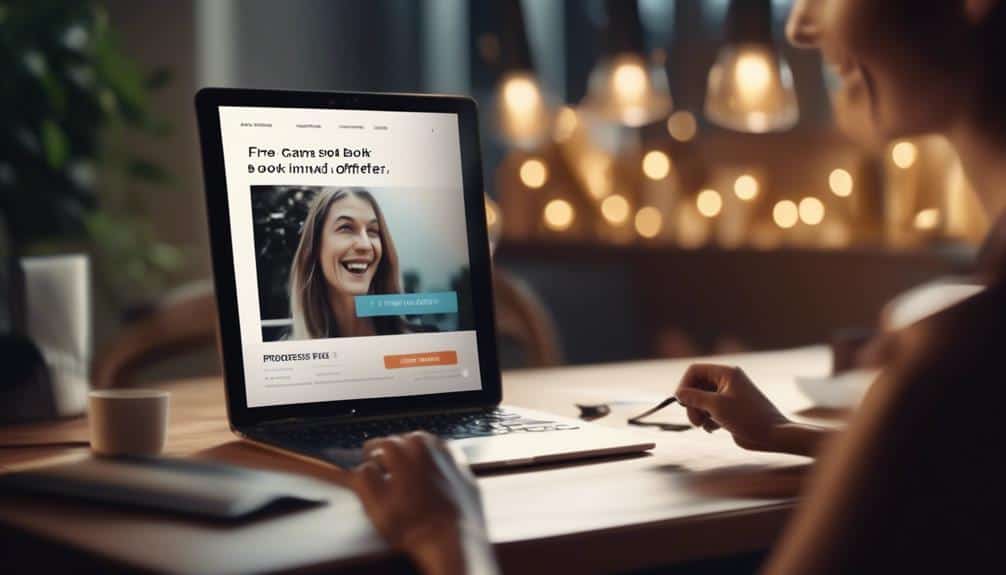
When it comes to designing landing pages aimed at boosting conversion rates, understanding the influence of the reciprocity principle is crucial.
By acknowledging the power of reciprocity in persuasion, you can tap into the psychological mechanism of giving to receive.
This principle creates an obligation to reciprocate, making visitors more likely to take the desired action on your landing page.
Reciprocity in Persuasion
Understanding the power of reciprocity in persuasion can significantly impact the effectiveness of your landing page design in converting visitors into customers. Leveraging the reciprocity principle can create a sense of obligation in your visitors, increasing the likelihood of them taking the desired action.
Here are four key strategies to implement reciprocity on your landing page:
- Offer a valuable resource for free to visitors.
- Provide personalized recommendations based on visitor interactions.
- Run limited-time promotions with exclusive benefits.
- Create interactive elements that engage visitors and enhance their experience.
Giving to Receive
To effectively harness the reciprocity principle on your landing page, consider how your acts of giving can influence visitors' willingness to receive and reciprocate, ultimately driving conversion rates. By offering valuable content, free resources, or exclusive deals, you aren't only providing immediate benefits to your audience but also building relationships and fostering trust.
When visitors feel that you have already given them something of value, they're more likely to reciprocate by engaging further with your site, signing up for newsletters, or making a purchase. This reciprocity loop creates a positive cycle where your initial act of giving leads to increased engagement and conversions.
Obligation to Reciprocate
Curious about how the reciprocity principle influences the obligation to reciprocate on your landing page? Understanding the social obligation created by the reciprocity principle in persuasive design can significantly impact the conversion rates of your website.
Here are four key insights to consider:
- Reciprocity Influence: Utilize the principle of reciprocity to offer valuable content or incentives to visitors.
- Landing Page Optimization: Enhance your landing pages with personalized offers that trigger the reciprocity effect.
- Behavioral Triggers: Implement interactive elements that encourage users to engage and reciprocate.
- Long-Term Relationships: Build trust and loyalty by consistently providing value, fostering a continuous cycle of reciprocity.
Utilizing Authority Figures

When aiming to boost conversion rates on your landing pages, incorporating endorsements from recognized industry experts can significantly enhance your credibility and persuade visitors to take action. By leveraging authority credibility and influencer partnerships, you can establish trust signals that resonate with your audience and drive conversions. Below is a table outlining the benefits of utilizing authority figures on your landing pages:
| Benefits of Utilizing Authority Figures |
|---|
| 1. Increases credibility and trust |
| 2. Enhances brand reputation |
| 3. Boosts conversion rates |
| 4. Drives engagement with visitors |
| 5. Improves overall brand perception |
Creating Emotional Connections
To maximize your landing page's effectiveness, consider the power of emotional design impact. Emotional connections can be forged through compelling storytelling, resonating with your audience on a deeper level.
Utilize visually appealing elements to capture attention and foster engagement with your brand.
Emotional Design Impact
Crafting landing pages that evoke specific emotions can significantly impact the conversion rates of a website. When it comes to Emotional Design Impact, understanding color psychology and emotional responses can play a crucial role in engaging your audience. Similarly, paying attention to design aesthetics and enhancing user experience can create a seamless journey for visitors on your landing pages.
To maximize the emotional connection with your audience, consider these key strategies:
- Utilize color psychology to evoke desired emotions.
- Trigger emotional responses through captivating visuals.
- Optimize design aesthetics for a visually appealing layout.
- Enhance user experience to create a seamless and engaging interaction.
Connection Through Storytelling
Understanding the emotional impact of storytelling on your landing pages can deepen the connection with your audience, fostering a sense of engagement and resonance. By incorporating storytelling techniques into your design, you can create a more compelling narrative that resonates with visitors on an emotional level. This emotional engagement is crucial in driving conversions and building lasting relationships with your audience. To illustrate the power of storytelling, consider the following table:
| Storytelling Technique | Emotional Engagement |
|---|---|
| Personal Narratives | Creates empathy and relatability |
| Visual Storytelling | Evokes strong emotions and memories |
| Conflict Resolution | Builds tension and resolution for engagement |
Utilizing these techniques can transform your landing pages into immersive experiences that captivate your audience and drive them towards action.
Visual Appeal for Engagement
Enhancing the visual appeal of your landing pages can significantly elevate emotional connections with your audience, fostering a more engaging user experience. When it comes to engaging visuals and user experience, consider the following:
- Interactive Elements: Incorporate interactive features like sliders or hover effects to captivate your audience.
- Consistent Branding: Ensure that your visuals align with your brand identity to create a cohesive and memorable experience.
- High-Quality Imagery: Use crisp, high-resolution images to draw users in and convey professionalism.
- Whitespace Utilization: Strategic use of whitespace can enhance visual hierarchy and guide users' attention effectively.
Crafting Compelling CTA Buttons
Effective call-to-action buttons can significantly impact the conversion rate of your landing page. When it comes to CTA button design, consider the principles of color psychology. The color of your CTA button can evoke different emotions and behaviors in your visitors. For instance, red can create a sense of urgency, while green can convey safety or 'go ahead.' Think about your brand's personality and the action you want users to take.
To craft compelling CTA buttons, choose colors that contrast with your page's background to make them stand out. Use bold, vibrant colors for your buttons to draw attention. Additionally, ensure that the text on the button is concise, action-oriented, and creates a sense of urgency. For example, instead of 'Submit,' try 'Get Started Now' to prompt immediate action. Experiment with different color combinations and text variations to see what resonates best with your audience. Remember, the goal is to guide visitors seamlessly towards the desired action.
Importance of Visual Elements

Visual elements play a crucial role in capturing attention and guiding user interaction on a landing page. When considering the importance of visual elements, keep in mind the following key factors:
- Color Psychology: Utilize colors strategically to evoke specific emotions and create a visually appealing experience for your audience. Different colors can elicit different responses, so choose wisely based on your target demographic and desired outcome.
- Imagery: Incorporate high-quality images that resonate with your brand and message. Visual representations can convey information more effectively than text alone and can leave a lasting impression on visitors.
- Design Consistency: Maintain a coherent design throughout your landing page to enhance brand recognition and establish credibility. Consistent visuals help users navigate the page seamlessly and build trust in your brand.
- Branding: Integrate your brand elements such as logos, fonts, and colors consistently across the page to reinforce brand identity. Strong branding creates a memorable experience and reinforces brand association in the minds of visitors.
Optimizing Page Load Speed
As your landing page design elements contribute significantly to user engagement, optimizing page load speed becomes imperative for ensuring a seamless user experience and maximizing conversion rates. In today's fast-paced digital world, users expect instant access to information, especially on mobile devices. Therefore, prioritizing mobile responsiveness is crucial to cater to a wide range of users and enhance their overall experience. Additionally, ensuring browser compatibility across different platforms and devices is key to reaching a broader audience and preventing potential barriers to entry.
Furthermore, image optimization plays a vital role in speeding up page load times. By compressing images without compromising quality, you can reduce loading times significantly, improving user satisfaction and retention. Remember, every second counts when it comes to capturing and maintaining user interest. By implementing these optimizations, you not only enhance the user experience but also increase the likelihood of converting visitors into customers. Stay ahead of the curve by continuously monitoring and refining your page load speed for optimal results.
A/B Testing for Continuous Improvement

To achieve continuous improvement in your landing page performance, consider implementing A/B testing as a strategic method for optimizing user experience and maximizing conversion rates. A/B testing involves comparing two versions of a webpage to see which one performs better based on specific metrics. Here's why A/B testing is crucial for your landing page success:
- Conversion Tracking: A/B testing allows you to track conversions accurately, giving you valuable insights into what elements of your page are driving user actions.
- Data Analysis: By analyzing the data gathered from A/B tests, you can make data-driven decisions to refine your landing page for better performance.
- User Experience: A/B testing helps you understand how different design elements impact user experience, enabling you to create a more user-friendly interface.
- Design Optimization: Through A/B testing, you can continuously optimize your design elements such as CTAs, images, and copy to enhance overall page effectiveness.
Frequently Asked Questions
How Can Personalization on Landing Pages Impact Conversion Rates?
When you tailor landing pages with personalized recommendations and customized messaging, user experience improves significantly. This optimization elevates conversion rates by addressing individual needs and preferences, creating a more engaging and relevant interaction for visitors.
What Role Does Trust Play in the Psychology of Persuasion on Landing Pages?
Trust building is paramount in persuasion. Establishing credibility fosters strong customer relationships, leading to an emotional connection with your brand. This trust breeds loyalty, enhancing conversions through a foundation of reliability and authenticity on landing pages.
Are There Any Ethical Considerations to Keep in Mind When Using Persuasive Tactics on Landing Pages?
When utilizing persuasive tactics on landing pages, it's crucial to be mindful of ethical considerations. Striking a balance between achieving conversion rates and respecting user trust is essential for long-term success and positive brand reputation.
How Does the Use of Storytelling Impact the Effectiveness of a Landing Page?
To enhance your landing page effectiveness, utilize storytelling. By weaving a narrative structure and employing visual storytelling, you can establish an emotional connection with users, driving user engagement and fostering a more persuasive environment.
Can the Use of Humor on Landing Pages Increase Conversion Rates, and if So, How Should It Be Implemented?
Using humor on landing pages can boost conversion rates by creating a memorable experience. Incorporate visual elements and a light-hearted tone. Make the humor align with your brand and audience. End with a clear call to action for maximum impact.
Conclusion
By incorporating the psychology of persuasion into your landing pages, you can significantly increase your conversion rates.
The power of social proof, scarcity tactics, reciprocity principles, authority figures, emotional connections, compelling CTA buttons, visual elements, page load speed optimization, and A/B testing are all key elements in creating a successful landing page.
By implementing these strategies, you can create a more engaging and effective user experience that will ultimately drive more conversions for your business.
